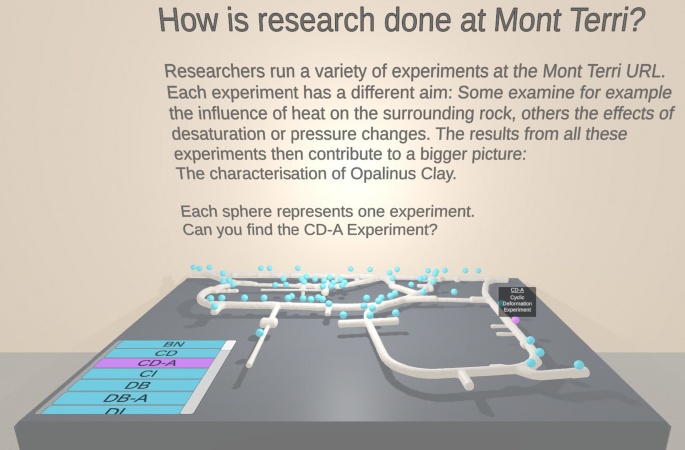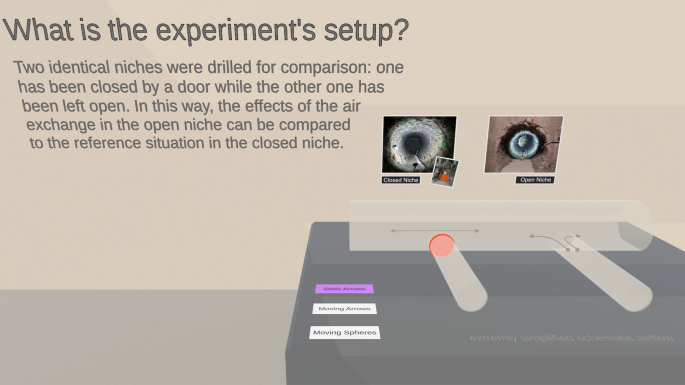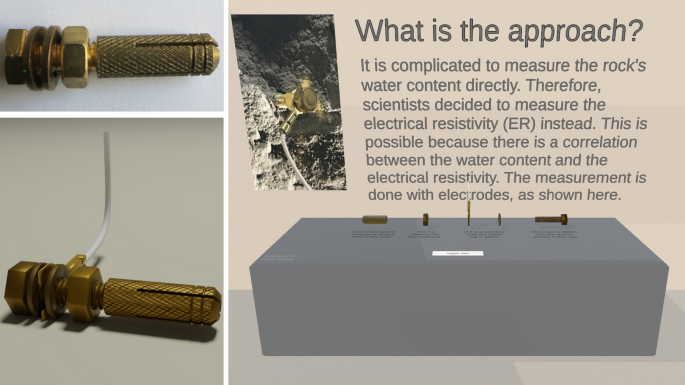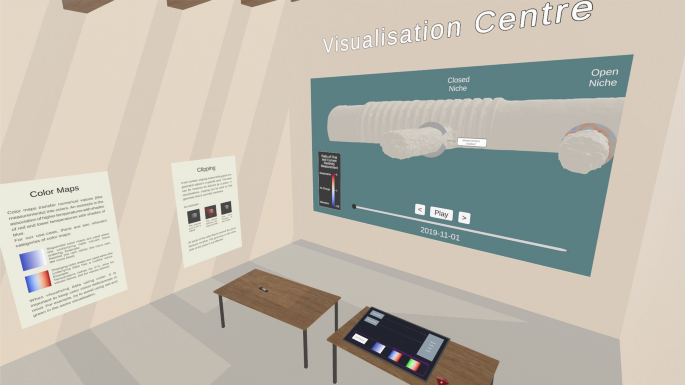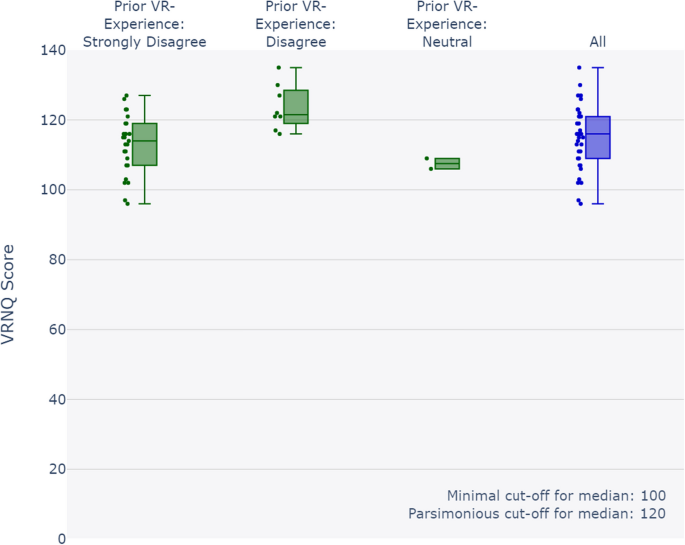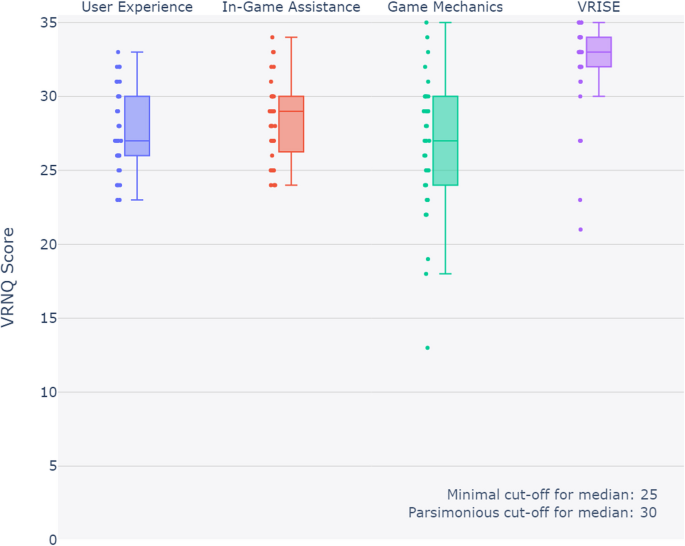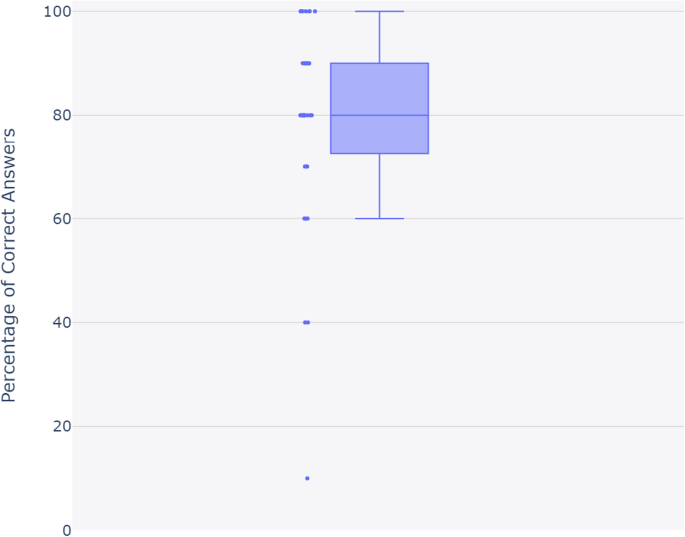Abstract
This paper presents the design, implementation, and evaluation of VR-EX, a combination of a virtual field trip and a serious game in immersive virtual reality. The application’s purpose is the communication of research conducted in the Mont Terri underground research laboratory in Switzerland. VR-EX enables users to actively attend electrical resistivity tomography measurements within a geological experiment, from planning to execution to analysis of the results, and in this way implements an active and playful learning approach. The work conducted in underground research laboratories has a high relevance for society as it contributes to research on the final disposal of nuclear waste. Therefore, the active communication of research methodology and results is crucial to increase understanding of scientific processes and boost interest. VR-EX was evaluated in a user study with 35 participants to measure its overall quality and its effectiveness of the knowledge transfer. Taking the evaluation’s qualitative results into account, the application was improved in an iterative process. Overall, the results prove the good quality of the application and its high effectiveness in terms of knowledge transfer. The reported high engagement, joy, and immersion indicate the benefits of employing immersive virtual reality for vivid science communication.
Similar content being viewed by others
Avoid common mistakes on your manuscript.
Introduction
In this work, we design, implement and evaluate VR-EX (Virtual Reality EXperiment), an immersive virtual reality application about a geological experiment at the Mont Terri underground research laboratoryFootnote 1 (URL) in St. Ursanne, Switzerland. The virtual reality (VR) application is designed to be used with head-mounted displays (HMD). It is a combination of a serious game and a virtual field trip and was developed for the purpose of science communication. VR-EX enables users to actively attend the experiment from planning to execution to analysis of the results. In the following, the motivation for the project as well as its requirements are described.
In underground research laboratories, researchers investigate, among other matters, potential host rocks for the final disposal of radioactive waste. An example of such a research facility is the Mont Terri URL in the north-west of Switzerland, where the characteristics of the Opalinus Clay formation are explored in various experiments at the original scale of a deep geological repository. Due to the high social relevance of radioactive waste research, science communication is a crucial aspect of the work in URLs. This is especially the case in the participative processes during site selection, as required by law, for example, in Germany (Di Nucci and Brunnengräber 2023). Knowledge about the research methods and results that are relevant for science-based decision-making is an essential requirement for forming an opinion. However, science communication for URLs often relies on traditional passive media and — despite the need for digitalisation [see also Kolditz et al. (2023)] — does not yet utilise modern digital formats. Therefore, the outreach is limited. In order to address this issue, we combined the concepts of virtual field trips and serious games, aiming to enrich science communication for the Mont Terri URL with modern formats. At the start of the project, five requirements were identified based on the objectives, the target group’s needs and the areas of application: (1) the format of science communication has to be vivid and engaging; (2) in addition to presenting the research methodology and results, the interdisciplinarity of the work at Mont Terri should also be highlighted; (3) the content needs to be comprehensible even without prior knowledge of the scientific background; (4) the application has to be usable without prior experience with the medium (i.e. VR); and (5) due to the planned use at varying places (e.g. at information events or in hands-on museums), the application should be suitable for mobile use.
The following Section “Fundamentals and related work” will explain the fundamental concepts used as well as the related work. An overview of the application is given in Section “Application overview”, while technical details are described in Section “Technical details”. The study design for evaluating the application is presented in Section Study design” and the evaluation results are described in Section “Evaluation results”. The paper concludes with a discussion of the work in Section “Discussion and conclusion”.
Fundamentals and related work
Virtual reality
Sherman and Craig defined Virtual Reality as “a medium composed of interactive computer simulations that sense the participant’s position and actions and replace or augment the feedback to one or more senses, giving the feeling of being mentally immersed or present in the simulation (a virtual world)” (Sherman and Craig 2018). Based on the type of the output device, desktop VR (dVR) and immersive VR (iVR) are differentiated. The latter uses HMDs or CAVEFootnote 2-like setups and in this way provides a higher degree of immersion compared to dVR. In general, VR applications have the potential to allow users to visit places that can not be visited that easily in the real world. Another benefit is the possibility for developers to virtually recreate interactions that are unsafe for the users or their environment in the real world. In the context of this work, these benefits are used to virtually bring users to the Mont Terri URL without the costs of travelling there and to allow them to actively re-enact an experiment, which would not be possible in real life. While VR is not yet often used for science communication (Behm-Morawitz and Shin 2024), concepts and best practices can be adopted from virtual learning environments in general (Matovu et al. 2023). This is the case for the following immersive design features, proven to be relevant for the development of iVR science learning applications: sensory (visual, audio, haptics), actional (interactivity, embodied movement, virtual body ownership), narrative (character, storyline, challenge) and social (social interactions) (Matovu et al. 2023; Won et al. 2023). The implementation of these design features in VR-EX will be explained in detail in Section “Application overview”.
Virtual field trips
The benefits of employing VR for education are particularly strong in the geo-scientific context [e.g. in Zhao et al. (2020), Janiszewski et al. (2020), Graebling et al. (2024)], in which learning often requires access to material samples or travelling to sites, which is economically and ecologically challenging. Therefore, the concept of virtual field trips was established and Klippel et al. (2019) defined a taxonomy for virtual field trips based on the extent of their features. VR-EX matches the criteria of an Advanced Virtual Field Trip, as the application not only virtually replicates the Mont Terri URL but also includes advanced interactions and provides measurement results over time.
Serious games
Based on the definition by Dörner et al., “a serious game is a digital game created with the intention to entertain and to achieve at least one additional goal (...)”, called the characterising goal (Dörner et al. 2016, p. 3). VR-EX can be considered a learning game, as its characterising goal is the transfer of knowledge about research at the Mont Terri URL. The game elements implemented in the application are described in Section “Application overview”. Serious games engage and motivate users extrinsically (Dörner et al. 2016, p. 61). This advantage is increasingly being exploited in education, where serious games in iVR are being used as digital learning environments (Checa and Bustillo 2020).
Perspectives from teaching and learning
VR-EX poses a scientific question to the user and asks them to support researchers in conducting an experiment in order to answer this question. While the application provides background information and research material, the problem is solved by the user in an individual learning process. This can be considered a mixture of problem-based and inquiry-based learning as described by Gavrić and Radivojević in the context of teaching nature and society (Gavrić and Radivojević 2022). The approach assigns the learner an active role and in this way supports the creation of a deeper understanding instead of pure transfer of information. Viewed from the perspective of teaching and learning, VR-EX implements an informal learning approach. Based on Sánchez-Mora’s taxonomy for public communication of science activities, VR-EX combines both, the playful and the meaningful aspects of informal learning (Sánchez-Mora 2016). Even if the application’s approach is based on informal learning in the context of science communication, some concepts from formal learning are transferable. This is the case for the connection of research and teaching in formal learning environments, because VR-EX presents actual research methodology and results. Based on Griffiths’ definitions, the learning processes within VR-EX can be considered a mixture of a research-led (content based on research) and a research-oriented (understanding of research processes) approach (Griffiths 2004).
Application overview
The following section describes the storyline of VR-EX including the introductory tutorial. For a more vivid impression of the immersive VR application, please refer to the video recording of an exemplary play-through, which is available online.Footnote 3 The video shows the serious game after the adaptations based on the feedback from the evaluation.
Virtual reality tutorial
In the introductory tutorial, users are taught the virtual interactions needed for attending the iVR serious game. This includes moving around in the virtual world by normal movements as known from the real world as well as the concept of teleportation. The latter refers to pointing at a place and pushing a controller button in order to move there without actually moving in the real world. This concept is required because the available physical space for moving in the real world is often more limited than in the virtual world. Besides moving, the tutorial introduces two types of interactions with virtual objects: grabbing (e.g. for transporting an object from one place to another) and activating objects that are currently grabbed (e.g. turning on a drill). The tutorial provides the explanations in a variety of formats (audio comments, textual explanations and images that demonstrate the required actions) in order to account for different learning material preferences. After completing the tutorial, the storyline is presented.
Introduction of the storyline
In the first scene of VR-EX, the user is introduced to the basic storyline and their role: They travel back in time to the year 2019 and are taken to St. Ursanne, Switzerland. There, the user is a regular visitor of an exhibition about the Mont Terri URL — until they receive a message asking for their help in the completion of an experiment. By presenting the character (being a regular visitor), the storyline (being asked for help in running an experiment) and the challenge (collecting all information and actually running the experiment), VR-EX implements the three elementary narrative design features for iVR-based learning (Matovu et al. 2023). After the introduction, the user is automatically taken to the first room of the virtual exhibition.
Virtual exhibition
The conceptual purpose of the virtual exhibition is to provide all relevant background information needed for running the experiment. The exhibition consists of three rooms. It begins with general information about the Mont Terri URL and becomes more specific by providing the background of the experiment and its measurements that will be conducted by the user.
The first room presents background information about the Mont Terri URL. This includes an introduction to the concept of URLs in general, the location of Mont Terri, its geological context and the importance of research in URLs for the final disposal of radioactive waste. These information are presented in classical formats like written notes and posters. In addition, an interactive exhibit displays a miniature version of the URL including a sphere for each of the most important experiments run at Mont Terri (see Fig. 1). When the user selects an experiment by its abbreviation from the list, the corresponding sphere is highlighted and the experiment’s full name is displayed. In addition, the selection of experiments is possible by interacting directly with the spheres. By entering this first room, the user receives a video message from the coordinator of Mont Terri’s visitor centre. She provides additional background information and tells the user that unfortunately nobody can be on site to complete important installations and measurements and asks the user for their help. In addition, the user gets the task to find the Cyclic Deformation Experiment (CD-A) in the miniature model of the tunnel system,Footnote 4 which is possible by either selecting it from the list or by selecting the corresponding sphere. The user earns a virtual diamond when they successfully select the CD-A experiment. Similar to this, all interactions with virtual exhibits are rewarded. This provides external motivation for the user to interact with the virtual world. Video messages from domain experts (non-player characters) guide the user through the whole game. In this way, not only the interdisciplinarity of research at Mont Terri is highlighted but research is also presented in a personal way, which implements a social design feature (Matovu et al. 2023).
In the second room, the user finds information about the CD-A experiment. When entering the room, they receive a video message from the experiment’s principal investigator, who explains the experiment. The setup of the CD-A experiment consists of two similar niches. As Fig. 2 shows, one of the niches is closed by a door, while the other is left open. This allows to compare the situation with and without air exchange. In this way, researchers investigate the influence of the climatic conditions in the tunnel system and the opening time of the niches on the surrounding rock mass in order to determine whether the excavation stability and rock mass permeability, which are important for the final disposal, are permanently affected [see Graebling et al. (2022) for details about the experiment]. Besides posters and texts about the background of the experiment, a simplified 3D model of the twin niches is presented (see Fig. 2). The user can investigate the difference of the airflow in the niches in this model and is asked to answer a quiz question about the experiment’s setup before moving to the next room. In this way, it is guaranteed that the difference of the airflow in the closed and open niche is understood, as this knowledge is crucial for the further experiment. The correct answering of quiz questions is rewarded with virtual diamonds.
The third room presents the actual type of measurement within the CD-A experiment that will be performed by the user: the electrical resistivity tomography (ERT). The motivation and the measurement procedure are explained by the researcher who runs the measurement in the real world in a video message. The sensor used for the ERT measurements is depicted in Fig. 3. It is available in two views: a normal assembled mode and an exploded view that provides explanations for all individual parts. For each ERT measurement, two of these sensors inject current and two additional sensors measure the potential difference between them. In this way, approximately 70 sensors per niche (all capable of both tasks) provide information about the electrical resistivity of the rock mass volume around both niches. By conducting these measurements, researchers can draw conclusions about the water content. This is based on the correlation that the higher the electrical conductivity of the rock mass, the higher the water content in the rock’s pores. This important information is again asked for in a quiz that must be solved before entering the next room.
Preparation
After the visit of the virtual exhibition, the user has the necessary background information about the ERT measurements performed within the CD-A experiment. The last step before entering the tunnel system in order to install the sensors and to start the measurement is to put on safety gear, i.e. a helmet and a safety vest. This has two conceptual purposes. First, the procedure increases the feeling of embodiment and the virtual body ownership [(which are actional design features (Matovu et al. 2023)] because the user sees their own avatar in the mirror matching their real world movements while putting on the safety gear. Second, the procedure replicates the preparation required when entering the actual tunnel system in the real world and in this way increases the realism and authenticity of visiting the tunnel system.
Exploring the tunnel system
When entering the tunnel system, the user receives a video message from a visitor guide. The message contains basic information about the tunnel system’s position and length and finally asks the user to find the CD-A niches. A map in the user’s left hand shows the current position and orientation as well as the location of the CD-A experiment. This supports the user in finding their way through the complex tunnel system. Finding the twin niches of the CD-A experiment is considered part of the main quest. In addition, the guide explains the optional side quest: Six polaroid cameras and six 360 degree panorama pictures (see the video of the play-through for a vivid impression and Section “Data integration” for technical details) are placed in the tunnel system and can be visited by the user. These provide photographs of the laboratory and in this way give real impressions instead of only showing the tunnel’s untextured geometry. Counters of the already visited cameras and panoramas are displayed on the map. This matches the concept of collectables from game development, which externally motivates the users to explore the tunnel system.
The closed niche of the CD-A experiment viewed from the tunnel system, including the red area marking the users aim for entering and the turquoise box, containing the measurement computer (left) as well as the perspective from inside the closed niche showing the drill and the three sensors for the installation (right)
Sensor installation
Upon reaching the CD-A niches, another video message from the experiment’s principal investigator welcomes the user and explains that the twin niches they are now facing are the same as presented in the virtual exhibition. After this recap, the user is asked to enter the closed niche. Figure 4 shows the niche viewed from outside and inside. On entering, the user receives a video message from the deputy site manager for the underground laboratory in which they are asked to complete the sensor installation for the last three sensors. This process consists of three steps: drilling of boreholes, placing the sensors inside the boreholes, and connecting all three sensors to their cables. Each step is rewarded with one diamond per sensor, resulting in nine diamonds for the entire installation. Afterwards, the user leaves the niche and starts the measurements on the experiment’s computer. This is followed by a narrative leap approximately one year into the future.
Visualisation and analysis
In the visualisation centre (see Fig. 5), the user is first guided by a video message to process the measured raw data (see Section Measurement results for details about the data integration). The underlying complex process is symbolised by pushing a button in order to keep the serious game accessible also for users without a mathematical or geophysical background. Afterwards the user receives a video message from a researcher specialised in geo-scientific visualisation, asking them to create the visualisation of the measurements for the large screen using the small screen on the table. To achieve this, the user adds all relevant data to the visual scene, colourises them and hides the part of the geometry that occludes the areas relevant for the analysis (see the video of the play-through for details). Two posters introduce the concepts of colour mapping and clipping and support the user in building the correct rendering pipeline by selecting predefined effects and elements. The successful creation of the visualisation is rewarded with diamonds. In a last step, the researcher running the experiment in the real world explains the analysis of the measurement results. The user can explore the outcome of their experiment in form of an animation of the results on the large screen. The main finding of the experiment is that, aside from seasonal effects, the open niche desaturates significantly stronger than the closed niche over the long term.
Technical details
Hardware and development
VR-EX was developed using the Unity Game EngineFootnote 5 and the XR Interaction Toolkit.Footnote 6 The target device is the Meta Quest 3, which is a standalone virtual reality head-mounted display with a per-eye display resolution of 2.064 pixels \(\times\) 2.208 pixels, 8 GB RAM and a Snapdragon XR2 Gen 2 processor.Footnote 7 Quest 3 supports two wireless controllers as default input devices and uses optical inside-out tracking, i.e. the headset’s cameras track its position by recognising visual features of the room in which the user moves. It therefore does not require further technical infrastructure like external tracking hardware. This fulfils the requirement of mobile usage.
Data integration
Tunnel system
A meshed representation of the tunnel system based on laser-scan data was available in the fbx-file-format. The original data set consists of approximately 4 million vertices and around 7.9 million faces. We preprocessed this data in BlenderFootnote 8 using custom python scripts for automatisation. The preprocessing consists of the following steps: (1) loading the original data set; (2) loading the ERT sensor positions from a csv-file; (3) creating a borehole for each ERT sensor in the mesh of the tunnel system using boolean operators; (4) splitting the tunnel system into 39 segments for optimisation in Unity (see Section “Optimisation”). Simplified representations of the whole tunnel system and of the CD-A niches were integrated into the first two rooms of the virtual exhibition and the visualisation centre.
Photos from the tunnel
As mentioned in Section “Photos from the tunnel”, six 2D photographs and six 360-degree panorama photos of the tunnel system are integrated in the application. For this purpose, each of the six panorama photos, available as equirectangular projections, is used for texturing a sphere’s inside. These spheres are placed at the original locations where the photo was taken and are deactivated in the scene by default. A sphere only gets activated when the user enters the panorama’s trigger. The additional six 2D photos are used as simple textures for the virtual pictures that get ejected by a polaroid camera when the user takes a photo. The polaroid cameras are also placed at the original location of the shot.
Measurement results
The ERT measurement results were available in vtk-file-format (Schroeder et al. 2006) as one file per niche and per day. We preprocessed these 696 files using ParaView.Footnote 9 In this step, the data from both niches was combined into a single file and a diverging colour-map (reflecting no change, saturation and desaturation) was applied. The resulting 348 files including results for both niches and the colour-map were then exported from ParaView and imported into the Unity scene.
Virtual rooms and 3D Models
The virtual exhibition and the visualisation centre were modelled in 3D using Unity’s ProBuilder.Footnote 10 The 3D models of objects used in the scenes were partly modelled in Blender and partly curated from online sources for royalty free assets (e.g. the safety vest). An example of an item modelled specifically for VR-EX in Blender is the ERT sensor, shown in Fig. 3.
Optimisation
Because the Quest 3 is a standalone HMD, its performance is limited compared to virtual reality setups that use the computing power of regular desktop PCs or even dedicated high performance graphics hardware. Therefore, two optimisation techniques were employed to increase the application’s graphics quality. Firstly, the 3D models used in the application are either low-poly meshes by design or were preprocessed using a polycount reduction modifier in Blender (Decimate Modifier). Secondly, the meshed representation of the tunnel system that is displayed when the user explores it at full scale (i.e. not as a miniature model in the exhibition) was split into 39 segments during the preprocessing (see Section “Tunnel system”). This allows the use of occlusion culling, i.e. not rendering the whole mesh but only the segments that are currently visible to the user.
Study design
Target group
In the context of this work, two of the potential objectives of science communication defined by Wack et al. (2021) are relevant: (1) to increase awareness and knowledge and (2) to boost interest and excitement. Because the motivation is not only to disseminate information, but also to engage individuals who are not yet interested, the target group for this work is formed by three sub-groups of the public: the general public (in this case excluding scientists from the field), the attentive public (“reasonably well-informed”) and the interested public (“not necessarily well informed”) (Burns et al. 2003). The areas of application for VR-EX are the URL’s visitor centre, information events and hands-on museums.
Evaluating the VR-quality
The application’s overall VR-quality was measured using the Virtual Reality Neuroscience Questionnaire (VRNQ) (Kourtesis et al. 2019a, b). Originally, this questionnaire was designed for usage in evaluating iVR applications in the field of cognitive neuroscience and neuropsychology, but due to its universality it is also applicable to iVR applications in general. VRNQ consists of four categories: user experience, game mechanics, in-game assistance and VR induced symptoms and effects (VRISE). Each category contains five questions that are answered on a 7-point-Likert scale. The scores are summed per category (0–35) and also per questionnaire (0–140). The higher the score, the better is the quality of the application. In order to classify the results, VRNQ defines two thresholds for the median score: a minimum cut-off (25 for categories, 100 overall) and a parsimonious cut-off (30 for categories, 120 overall). In addition to the quantitative score, each question is followed by a free-text input field for additional qualitative feedback.
Evaluating the knowledge transfer
In order to measure the knowledge gain, a test about the content of VR-EX was designed and presented to the participants after they attended the serious game. This test is provided in Online Resource 1. In collaboration with domain experts, it was decided that the knowledge which is needed to answer the questions is specific enough to consider the prior knowledge as insignificant. Therefore, all correctly answered questions are considered as knowledge gain. The effects of guessing are also assumed to be insignificant because the participants were explicitly asked not to guess and the results of the knowledge test were recorded and processed anonymously. In addition to the knowledge test, the participants were asked for their subjective estimation of their detailed prior knowledge about the Mont Terri URL and the scientific processes run there before and after participating. The difference is considered the perceived knowledge transfer.
Pretest
VR-EX was developed in an iterative process. A first prototype was implemented after the conceptualisation phase. This prototype was tested with four participants in a pretest before the actual evaluation. The participants (3 male, 1 female) were aged between 23 and 46 years. One participant reported a geo-scientific background and another participant reported previous experience with VR. The pretest revealed the need for a clearer and longer tutorial and small changes in the interaction design. These adaptations were implemented before the evaluation took place. The second iteration of changes made to the application based on the evaluation are described in subsection “Qualitative analysis”.
Evaluation results
Participants
The evaluation was advertised via the social media accounts and mailing lists of the participating institutions and was open for all interested people of full age. Overall, 35 participants (16 female, 14 male, 5 other or not specified) took part in the evaluation, which was performed at Leipzig University and the UFZ. The participants were provided with a VR HMD for the duration of the evaluation. 14 of the participants reported to be of age 18–29, 11 to be in the thirties, 7 in the forties, 2 in the fifties and one participant was between 60 and 69 years old. The participants’ highest level of education is listed in Table 1. When asked for their iVR experience, 33 of 35 participants reported not to be used to VR applications and 2 participants answered the question neutrally. The question about their detailed prior knowledge about the Mont Terri URL and the scientific processes run there was disagreed on by 34 participants (29 disagreed strongly) and one participant answered neutrally. None of the participants reported a colour-vision deficiency.
Duration of participation
Both, the average and median duration of the participation in the iVR application was approximately 31 min. The fastest participant took 23 min and the slowest 41 min. Due to language-based comprehension problems, two participants whose first language was neither English nor German were unable to complete the serious game within the evaluation’s organisational time frame of 45 min. In these cases, the participation was stopped after the sensor installation was completed. Because the two participants only missed the last room of the game, they were not excluded from the evaluation.
Quantitative analysis
Figure 6 shows the ratings of the iVR application’s overall quality based on the VRNQ questionnaire. The median score taking all participants (blue) into account was 116 (average 115) which lies between the minimal (100) and the parsimonious cut-off (120) defined for VRNQ. Participants with little more experience with the medium iVR (“disagreed” instead of “strongly disagreed” when asked for being used to iVR) rated the application’s quality slightly better, resulting in a median score of 121. The lower score from participants who answered the question about iVR experience neutrally are not considered to be representative as the group consisted of only two participants. Figure 7 reports the application’s quality in more detail for each sub-category of the questionnaire. The minimum cut-off was exceeded in all categories. For VRISE the median score was even better than the parsimonious cut-off. Due to this overall very good result, the reasons for the two lower outliers in the VRISE evaluation (below 25) can be presumed to be individual instead of structural. In addition, the outliers do not outnumber the usual 5–10% of participants who experience symptoms independent of the actual application (Barrett 2004).
Qualitative analysis
In the qualitative analysis, the free-text feedback was summarised and sorted by frequency. The participants most frequently reported a high level of enjoyment, especially when interacting with the safety gear or the drill. Besides this positive feedback, the most frequently mentioned suggestion for improvement was related to the interaction mechanics, as some interactions were reported to be not intuitive or even inconsistent. Based on this feedback, after the evaluation the mentioned interactions were adjusted to be consistent and additional explanations were added for interactions that were deemed not intuitive enough. In addition, bugs were fixed and smaller adaptations were made. Examples for these minor changes are the increase of figure resolutions, the addition of more hints and notes as well as the improvement of the recorded video messages from domain experts.
Additional observations made by the person in charge of the evaluation highlight the strong immersion and presence felt in the virtual world. One participant let go of the controller and tried to grab the drill with their hand. Another made large and careful real-world steps in the niche in order not to damage the virtual cable channel. Furthermore, another participant reported considering the safety of entering the niche, in regards to the air supply for breathing.
Knowledge transfer
Figure 8 shows the results of the knowledge test. The median percentage of correct answers was 80% (same average). One participant answered only 10% of the questions correctly and two participants answered 40% correctly. All other participants reached 60% or better. The participant who reached only 10% is considered as outlier. Because of the otherwise very good results and the fact that they completed the serious game without severe problems, it is considered that this was due to their personal situation.
The median of the perceived knowledge gain was a 3 point improvement on a 5-point-Likert scale. Two participants reported no perceived knowledge gain. However, one of them answered 80% of the knowledge test’s questions correctly and the other one is the outlier described before. For one participant the subjective knowledge was even 4 points higher after the participation than before.
Discussion and conclusion
For the purpose of science communication for the Mont Terri URL, the concepts of virtual field trips and serious games were combined. The results of the iVR application’s evaluation show that the serious game is well usable also for people without prior knowledge from the field and without experience with the medium VR. In addition, the participants reported joy and engagement. The over-representation of participants who were not familiar with iVR applications suggests that even better results could have been achieved with a more heterogeneous group of participants, as typical when using VRNQ. Based on the participants’ feedback from the evaluation, the application was improved and it therefore can be considered that the final version after these adaptations would score even better than the evaluated version. However, a limitation of the study design is the measurement of knowledge transfer employing a test consisting of only ten questions and the knowledge transfer being measured only once directly after the participation. Future work could measure the achieved long-term knowledge transfer and investigate the application’s effect on the participants’ acceptance of nuclear waste management. Another limitation of the evaluation is the over-representation of young and highly educated participants. This can be explained by the fact that the announcement of the evaluation was primarily shared by research institutions. Nonetheless, the education-based limitation is only relevant for measuring the knowledge transfer and irrelevant for measuring the quality of the application. Future work could repeat the evaluation with less educated participants or with teenagers and older participants.
VR-EX clearly demonstrates the potential benefits of immersive virtual reality serious games for science communication by engaging users and assigning the learner an active role. In future work, VR-EX could be enhanced by personalisation and adaptation (Dörner et al. 2016, p. 10) in order to provide a learning process tailored to the user’s prior knowledge and interests. In this way, the application could also be used for a broader target group, also including formal learning. In this context, the participation of groups instead of single users could be evaluated. This can be realised either by implementing a multi-player mode or by streaming the VR headset’s graphics to an external display for shared participation. Besides the use for science communication and teaching, VR-EX could be developed further in order to not only disseminate research but also to support and initiate multi-party dialogues between the different stakeholders in nuclear waste management within site selection processes.
Data availability
No datasets were generated or analysed during the current study.
Notes
See https://www.mont-terri.ch/ and Bossart et al. (2018) for details.
Cave Automatic Virtual Environment: The immersive experience is created by projecting the virtual world onto the walls of a real-world room.
video recording of an exemplary play-through: https://youtu.be/mQP1iTlhSMU.
Strictly speaking, the term ‘underground drift network’ would be correct, but for simplification purposes the term ‘tunnel system’ is used in the application.
References
Barrett JN (2004) Side effects of virtual environments: a review of the literature. DSTO Information Sciences Laboratory, Edinburgh, Australia
Behm-Morawitz E, Shin H (2024) Using VR for science communication: presence, message perception, and pro-environmental effects. Sci Commun 46(1):36–64. https://doi.org/10.1177/10755470231217535
Bossart P, Bernier F, Birkholzer J, Bruggeman C, Connolly P, Dewonck S, Fukaya M, Herfort M, Jensen M, Matray J-M, Mayor JC, Moeri A, Oyama T, Schuster K, Shigeta N, Vietor T, Wieczorek K (2018) Mont Terri Rock Laboratory, 20 Years, 1st edn. Birkhäuser, Cham. https://doi.org/10.1007/978-3-319-70458-6
Burns T, O’Connor J, Stocklmayer S (2003) Science communication: a contemporary definition. Public Underst Sci 12:183–202. https://doi.org/10.1177/09636625030122004
Checa D, Bustillo A (2020) A review of immersive virtual reality serious games to enhance learning and training. Multimed Tools Appl 79:5501–5527. https://doi.org/10.1007/s11042-019-08348-9
Di Nucci MR, Brunnengräber A (2023). In: Arentsen M, Est R (eds) The long road towards the soft nuclear repository state: nuclear waste governance in Germany. Springer, Wiesbaden, pp 113–140. https://doi.org/10.1007/978-3-658-40496-3_5
Dörner R, Göbel S, Effelsberg W, Wiemeyer J (2016) Serious games: foundations, concepts and practice. Springer. https://doi.org/10.1007/978-3-319-40612-1
Gavrić N, Radivojević D (2022) Problem-based and inquiry-based learning in the teaching of nature and society. J Educ Soc Multicult 3(2):99–116. https://doi.org/10.2478/jesm-2022-0020
Graebling N, Şen ÖO, Bilke L, Cajuhi T, Naumov D, Wang W, Ziefle G, Jaeggi D, Maßmann J, Scheuermann G, Kolditz O, Rink K (2022) Prototype of a virtual experiment information system for the Mont Terri underground research laboratory. Front Earth Sci. https://doi.org/10.3389/feart.2022.946627
Graebling N, Althaus M, Şen ÖO, Reimann T, Cajuhi T, Scheuermann G, Kolditz O, Rink K (2024) Feels like an Indie Game evaluation of a virtual field trip prototype on radioactive waste management research for University Education. IEEE Comput Graph Appl 44(1):13–24. https://doi.org/10.1109/MCG.2023.3328169
Griffiths R (2004) Knowledge production and the research-teaching nexus: the case of the built environment disciplines. Stud High Educ 29(6):709–726. https://doi.org/10.1080/0307507042000287212
Janiszewski M, Uotinen L, Merkel J, Leveinen J, Rinne M (2020) Virtual reality learning environments for rock engineering, geology and mining education. In: U.S. Rock Mechanics/Geomechanics Symposium, pp 2020–1101
Klippel A, Zhao J, Jackson KL, La Femina P, Stubbs C, Wetzel R, Blair J, Wallgrün JO, Oprean D (2019) Transforming earth science education through immersive experiences—delivering on a long held promise. J Educ Comput Res 57(7):1745–1771. https://doi.org/10.1177/0735633119854025
Kolditz O, Jacques D, Claret F, Bertrand J, Churakov S, Debayle C, Diaconu D, Fuzik K, García Cobos D, Graebling N, Grambow B, Holt E, Idiart A, Leira P, Montoya V, Niederleithinger E, Olin M, Pfingsten W, Prasianakis N, Wendling J (2023) Digitalisation for nuclear waste management: predisposal and disposal. Environ Earth Sci 82:42. https://doi.org/10.1007/s12665-022-10675-4
Kourtesis P, Collina S, Doumas LAA, MacPherson SE (2019a) Validation of the virtual reality neuroscience questionnaire: maximum duration of immersive virtual reality sessions without the presence of pertinent adverse symptomatology. Front Hum Neurosci 13(417):1–13
Kourtesis P, Collina S, Doumas LAA, MacPherson SE (2019b) Virtual Reality Neuroscience Questionnaire (VRNQ). https://doi.org/10.1037/t83717-000
Matovu H, Ungu DAK, Won M, Tsai C-C, Treagust DF, Mocerino M, Tasker R (2023) Immersive virtual reality for science learning: design, implementation, and evaluation. Stud Sci Educ 59(2):205–244. https://doi.org/10.1080/03057267.2022.2082680
Sánchez-Mora MdC (2016) Towards a taxonomy for public communication of science activities. JCOM 15(2):709–726
Schroeder W, Martin K, Lorensen B (2006) The visualization toolkit, 4th edn. Kitware
Sherman WR, Craig AB (2018) Understanding virtual reality: interface, application, and design. The Morgan Kaufmann Series in Computer Graphics. Elsevier Science, Cambridge
Wack J, Jaeger C, Yuan S, Bergan-Roller HE (2021) A framework and lesson to engage biology students in communicating science with nonexperts. Am Biol Teach 83(1):17–25. https://doi.org/10.1525/abt.2021.83.1.17
Won M, Ungu DAK, Matovu H, Treagust DF, Tsai C-C, Park J, Mocerino M, Tasker R (2023) Diverse approaches to learning with immersive virtual reality identified from a systematic review. Comput Educ 195:104701. https://doi.org/10.1016/j.compedu.2022.104701
Zhao J, La Femina P, Carr J, Sajjadi P, Wallgrun JO, Klippel A (2020) Learning in the field: comparison of desktop, immersive virtual reality, and actual field trips for place-based STEM education. In: Proceedings—2020 IEEE Conference on Virtual Reality and 3D User Interfaces, VR 2020, 893–902. Institute of Electrical and Electronics Engineers Inc., International. https://doi.org/10.1109/VR46266.2020.1581091793502
Acknowledgements
The authors thank the participants of the pretest and the evaluation as well as the domain experts for recording the video messages. Furthermore, the funding by swisstopo is appreciated.
Funding
Open Access funding enabled and organized by Projekt DEAL. This work was supported by funding from the Federal Office of Topography (swisstopo), Switzerland. The authors have no relevant financial or non-financial interests to disclose.
Author information
Authors and Affiliations
Contributions
Author Contributions based on CRediT: N.G. had the lead in the conceptualization, methodology, software development, investigation, resources, formal analysis, data curation, visualization, project administration and wrote the original draft (including editing). G.Z. and M.F. supported the conceptualization and provided resources. S.S. supported the data curation and provided resources. M.Z., D.J., and C.N. supported the conceptualization. Y.A. supported the software development and the conceptualization. S.G. supported the investigation. K.R. supported the project administration. All authors reviewed the manuscript.Footnote 11
Corresponding authors
Ethics declarations
Conflict of interest
The authors declare no Conflict of interest.
Additional information
Publisher's Note
Springer Nature remains neutral with regard to jurisdictional claims in published maps and institutional affiliations.
Rights and permissions
Open Access This article is licensed under a Creative Commons Attribution 4.0 International License, which permits use, sharing, adaptation, distribution and reproduction in any medium or format, as long as you give appropriate credit to the original author(s) and the source, provide a link to the Creative Commons licence, and indicate if changes were made. The images or other third party material in this article are included in the article's Creative Commons licence, unless indicated otherwise in a credit line to the material. If material is not included in the article's Creative Commons licence and your intended use is not permitted by statutory regulation or exceeds the permitted use, you will need to obtain permission directly from the copyright holder. To view a copy of this licence, visit http://creativecommons.org/licenses/by/4.0/.
About this article
Cite this article
Graebling, N., Ziefle, G., Furche, M. et al. VR-EX — An immersive virtual reality serious game for science communication about the electrical resistivity tomography measurements in the Mont Terri Rock Laboratory, Switzerland. Environ Earth Sci 83, 318 (2024). https://doi.org/10.1007/s12665-024-11613-2
Received:
Accepted:
Published:
DOI: https://doi.org/10.1007/s12665-024-11613-2





